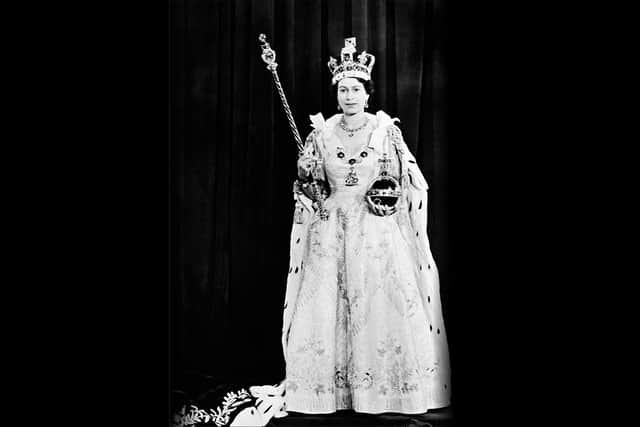Queen Elizabeth II: why South Africans want the Cullinan diamond returned plus what other jewels are claimed
This article contains affiliate links. We may earn a small commission on items purchased through this article, but that does not affect our editorial judgement.
and live on Freeview channel 276
The nation may still be in mourning following the death of Queen Elizabeth II, but there are some British colonies that are calling for the return of their jewels. The late Queen died at Balmoral Castle, Scotland, on Thursday 8 September and will be laid to rest following a state funeral at Westminster Abbey, London, on Monday 19 September.
Many of the stones are actually embedded within the crown jewels, and have been put on display repeatedly for this period of national mourning. So, just what is the Cullinan diamond, why does South Africa want it back, and what other jewels are being requested for their return?
Here’s everything you need to know.
Advertisement
Hide AdAdvertisement
Hide Ad

What is the Cullinan diamond?
The Cullian diamond is the world’s largest known clear-cut diamond which was discovered at 3,106 carats, weighing slightly over a pound. It was then cut into nine major stones and 96 smaller ones. One 500-carat piece of it, known as the Great Star of Africa, also known as Cullinan I, has been the centre piece in the Queen’s sceptre.
This stone was actually just one part of the much larger Cullinan diamond, which was discovered in South Africa in 1905 when the British ruled over the country. Another stone from the large diamond is also part of the crown jewels – the Cullinan II or Second Star of Africa sits on the front band of the Imperial State Crown.
It has always been the Great Star of Africa, however, that has drawn the most public attention. Queen Elizabeth II wore the Imperial state Crown and carried the Orb and sceptre during her 1953 coronation.
Why do South Africans want the Cullinan diamond back?
The reason why the South Africans want the diamond back actually dates many hundreds of years. When the British Empire was expanding and acquiring colonies in the 19th century, precious stones and other invaluable possessions were taken back to Britain. These were presented to the royal family as souvenirs or spoils of war.
Advertisement
Hide AdAdvertisement
Hide AdAlthough the late Queen was not alive during the height of British colonialism, she was seen as one of final connections to the UK’s imperial past, and now she has died these countries want their jewels back. South Africa is just one of these countries. South Africa formally became part of the British Empire in the early 19th century, and only became independent in 1931.
What have the South African people said about the Cullinan diamond?
More than 6,000 South African people have now signed a petition asking for the Great Star of Africa to be sent back to its supposed place of origin and put in a South African museum.
Local media reports suggest that many people believe that the country’s president President Cyril Ramaphosa should have asked for the stone to be returned, rather than offering his condolences over the Queen’s death.
Activist Thanduxolo Sabelo told local media: “The Cullinan Diamond must be returned to South Africa with immediate effect. The minerals of our country and other countries continue to benefit Britain at the expense of our people.”
Advertisement
Hide AdAdvertisement
Hide AdA member of the South African parliament Vuyolwethu Zungula also called for his government to demand the “return of all the gold, diamonds stolen by Britain” and leave the commonwealth on Twitter.
What other jewels do British colonies want back?
India, which was ironically once called the Jewel in the Crown of the British Empire, has now started calling for its own jewel back. The Koh-i-noor, which is also in one of Britain’s crowns, weighs around 105.6 carats, and is thought to have been discovered in southern India in the 1300s.
It is currently sitting at the top of the Queen Mother’s crown, which was first made in 1937 for her coronation as King George VI’s Queen consort. The jewel was said to be “cursed for men”, and so was first worn as a brooch by Queen Victoria, before being placed into separate crowns for Queen Alexandra and Queen Mary, according to ABC News.
It is currently on display in the Queen Mother’s crown in the Jewel House at the Tower of London. Some reports suggest it will be worn by Queen consort Camilla when King Charles is officially crowned at his coronation, but these reports are unconfirmed - and we still don’t know when the King’s coronation will be.
Advertisement
Hide AdAdvertisement
Hide AdTwitter users have called for the jewel to be returned. One simply said: “On behalf of Indians, we want our Kohinoor back.”
India was officially placed under British Crown rule in the 19th Century, and it did not become independent until 1947.
How much is the Cullinan diamond - and the other jewels - worth?
The value of the Cullinan diamond, and other precious jewels used by the British monarchy, is unknown. It’s safe to assume though that, given their history, they are worth a huge amount of money. They are extremely valuable - both financially and sentimentally.
What has the royal family said about the Cullinan diamond and the other jewels?
Buckingham Palace has not responded to the calls for the return of the jewels at the time of writing. It is thought that a discussion about the origins of the royal jewels may happen in the future, particularly as more Commonwealth nations are considering removing the monarch as their head of state.
Comment Guidelines
National World encourages reader discussion on our stories. User feedback, insights and back-and-forth exchanges add a rich layer of context to reporting. Please review our Community Guidelines before commenting.
